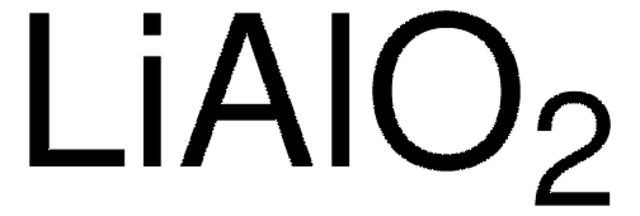400904
Lithium molybdate
99.9% trace metals basis
Synonyme(s) :
Dilithium dioxido(dioxo)molybdenum, Lithium Molybdate(VI), Lithium Molybdenum Oxide, Lithium metamolybdate
About This Item
Produits recommandés
Niveau de qualité
Pureté
99.9% trace metals basis
Forme
powder or crystals
Pertinence de la réaction
reagent type: catalyst
core: molybdenum
Caractéristiques du produit alternatif plus écologique
Design for Energy Efficiency
Learn more about the Principles of Green Chemistry.
sustainability
Greener Alternative Product
Impuretés
≤1500.0 ppm Trace Metal Analysis
Densité
2.66 g/mL at 25 °C (lit.)
Autre catégorie plus écologique
, Enabling
Chaîne SMILES
[Li+].[Li+].[O-][Mo]([O-])(=O)=O
InChI
1S/2Li.Mo.4O/q2*+1;;;;2*-1
Clé InChI
NMHMDUCCVHOJQI-UHFFFAOYSA-N
Description générale
Application
Mention d'avertissement
Warning
Mentions de danger
Conseils de prudence
Classification des risques
Eye Irrit. 2 - Skin Irrit. 2 - STOT SE 3
Organes cibles
Respiratory system
Code de la classe de stockage
13 - Non Combustible Solids
Classe de danger pour l'eau (WGK)
WGK 1
Point d'éclair (°F)
Not applicable
Point d'éclair (°C)
Not applicable
Équipement de protection individuelle
dust mask type N95 (US), Eyeshields, Gloves
Faites votre choix parmi les versions les plus récentes :
Déjà en possession de ce produit ?
Retrouvez la documentation relative aux produits que vous avez récemment achetés dans la Bibliothèque de documents.
Articles
Increasing fuel costs and concerns about greenhouse gas emissions have spurred the growth in sales of hybrid electric vehicles (HEVs) that carry a battery pack to supplement the performance of the internal combustion engine (ICE).
Nanomaterials for Energy Storage in Lithium-ion Battery Applications
Professor Qiao’s laboratory lays out recent advances in conversion type lithium metal fluoride batteries. This review explores key concepts in developing electrochemically stable microstructures for wide Li-ion insertion channels.
Li-ion batteries are currently the focus of numerous research efforts with applications designed to reduce carbon-based emissions and improve energy storage capabilities.
Notre équipe de scientifiques dispose d'une expérience dans tous les secteurs de la recherche, notamment en sciences de la vie, science des matériaux, synthèse chimique, chromatographie, analyse et dans de nombreux autres domaines..
Contacter notre Service technique
